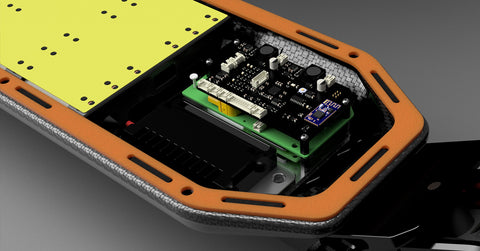Recently, we uncovered an issue that’s been flying under the radar for us—battery self-discharge. It’s something that hasn’t been a problem with regular use, but when you have to ship boards around the globe taking into account potential transit times, a different story emerges.
The Breakdown: Not Just A Simple Switch
All electric skateboards have a motor controller, and all motor controllers have large capacitors that store energy, which poses a challenge when it comes to simply switching your board on and off.
Powering a board up causes these capacitors to draw currents in excess of 2000A for a brief moment, resulting in arcing and damage to regular mechanical switches, so up until recently an electronic anti-spark MOSFET switch had to be used instead.
If you’ve been around the electric skateboard (e-skate) scene for a while, you’ve probably heard about the Focbox Unity motor controller. It’s one of the most popular VESC-based controllers out there, but it also had a notorious weak point: its MOSFET switch would fail over time.
To avoid this, the DV6s motor controller in the Mach One skips the MOSFET switch altogether. When the board is off, it drops the controller into a low-power sleep state rather than fully cutting the power. This avoids the reliability issues and simplifies the design—but it brings a new challenge.
The Hidden Issue: Battery Self-Discharge
While the motor controller’s sleep state uses minimal power, it still drains the battery slowly. Dangerous Goods regulations require us to ship the Mach One's lithium battery with less than 30% charge. Combine that with the slow self-discharge from the sleep state, and you’ve got a ticking clock—about 60 days before the battery could drain too low, leading to irreversible damage and requiring replacement.
Normally, a battery management system (BMS) would handle both overcharging and over-discharging. But for the Mach One, we bypass the BMS during discharge. Why? The high power output during acceleration would require a massive BMS to handle it without triggering faults, which could cause serious injury. This discharge bypass is common in the DIY community and with brands like Lacroix.
Learning From the Past: Avoiding the Lacroix Dilemma
Lacroix, another high-end e-skate brand, ran into trouble when boards arrived with dead batteries, thanks to self-discharge during shipping. Not only did they have to replace the priciest part of the board, but they also needed to pay someone to install it—all before customers could even take their first ride.
We suspect this contributed to their bankruptcy, and we’re determined to make sure that never happens with the Mach One.
Our Solution: Revamping the Switch for Longer Shelf Life
To eliminate this issue, we’ve decided to include a MOSFET anti-spark switch, fully cutting off power when the board is turned off. This change extends the battery shelf life from 60 days to over 200 days at 25% charge, and well over a year when stored properly.
But what about the longevity of the switch? Didn’t we just say those switches tend to wear out, like in the Focbox Unity? Here’s the difference: Our switch uses a pre-charge system, which gradually charges the large capacitors in the motor controller before activating the MOSFETs. This removes the damaging inrush current that eventually kills the simpler designs that are in widespread use.
Why It Matters
At Radium, we don’t just rely on our own experience. We learn from the e-skate community and the missteps others have made in the past. Our goal is to make the Mach One as reliable as it is cutting-edge, so you can spend more time riding and less time worrying about your board’s performance.
The Trade-Off: A Short Delay
Adding this new component means we need to do thorough performance and safety testing, which has set production back by up to 30 days. We know waiting isn’t fun, but we’re confident that this change is worth it. Delays are frustrating, and an apology is in order to all buyers of the Mach One for any inconvenience this may cause.
To date, the circuit design for the new MOSFET anti-spark switch is complete, and parts have already been ordered for the first prototype. The team is gearing up to assemble and test the prototype starting this weekend. Once testing is complete and everything checks out, production will continue with the upgrade, ensuring that the Mach One delivers the reliability and performance expected.
We’re incredibly grateful for your patience and support while we make sure the Mach One is everything it’s meant to be—and more.
Stay tuned, and we’ll have you out on the streets soon.


